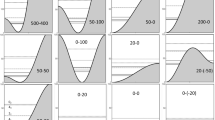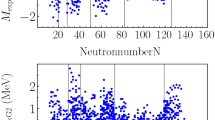Abstract
We propose a method to select core and cluster in a binary component description of atomic nuclei. The choice is based on the mismatch between measured binding energies and the underlying trend supplied by the liquid drop model. A key point is that the charge to mass ratios of parent, core, and cluster should be as nearly equal as possible. This approach reinforces our earlier conclusions concerning the occurrence of exotic clustering in actinide nuclei and also reveals a competing binary mode in these nuclei in which the cluster charge and mass are substantially larger than those corresponding to an exotic decomposition. In fact, this additional mode corresponds to superdeformation, and we predict that it should be widespread across the Periodic Table. In binary models, the transition quadrupole moments Q t of superdeformed (SD) bands depend strongly on the charge and mass splits, but are rather insensitive to other details. Indeed, given the cluster charge 〈Z 2〉, Q t can be determined algebraically. We compare calculations of transition quadrupole moments with the measured values for the 41 SD bands in 21 even-even nuclei for which experimental data are available. The mass range is from A∼60 to A∼240 and the values of Q t vary from ∼3 to ∼30 e b. A good level of agreement is obtained.
Similar content being viewed by others
References
A. Arima et al., Adv. Nucl. Phys. 5, 345 (1972).
K. Wildermuth and Y. C. Tang, in A Unified Theory of the Nucleus (Academic, New York, 1977), p. 1.
H. Furutani et al., Prog. Theor. Phys. Suppl. 68, 193 (1980).
S. Ohkubo, Prog. Theor. Phys. Suppl. 132, 1 (1998).
B. Buck, A. C. Merchant, S. M. Perez, et al., J. Phys. G 20, 351 (1994).
B. Buck, A. C. Merchant, and S. M. Perez, Phys. Rev. Lett. 76, 380 (1996); Phys. Rev. C 58, 2049 (1998); 57, R2095 (1998); 59, 750 (1999).
B. Buck, A. C. Merchant, and S. M. Perez, Nucl. Phys. A 652, 211 (1999); 657, 267 (1999).
B. Singh, R. B. Firestone, and S. Y. Frank Chu, Nucl. Data Sheets 78, 1 (1996).
X. L. Han and C. L. Wu, At. Data Nucl. Data Tables 73, 43 (1999).
B. Buck, A. C. Merchant, M. J. Horner, et al., Phys. Rev. C 61, 24314 (2000).
W. S. C. Williams, in Nuclear and Particle Physics (Clarendon Press, Oxford, 1991), p. 60.
B. Buck and A. A. Pilt, Nucl. Phys. A 280, 133 (1977).
D. G. Ravenhall, Rev. Mod. Phys. 30, 430 (1958).
B. Buck, A. C. Merchant, and S. M. Perez, Nucl. Phys. A 614, 129 (1997).
B. Buck, A. C. Merchant, and S. M. Perez, Nucl. Phys. A (in press).
B. Buck, A. C. Merchant, and S. M. Perez, Phys. Rev. C 61, 14310 (2000).
Author information
Authors and Affiliations
Additional information
From Yadernaya Fizika, Vol. 65, No. 4, 2002, pp. 701–705.
Original English Text Copyright © 2002 by Buck, Merchant, Perez.
This article was submitted by the authors in English.
Rights and permissions
About this article
Cite this article
Buck, B., Merchant, A.C. & Perez, S.M. Transition quadrupole moments in superdeformed bands. Phys. Atom. Nuclei 65, 669–673 (2002). https://doi.org/10.1134/1.1471271
Received:
Issue Date:
DOI: https://doi.org/10.1134/1.1471271




